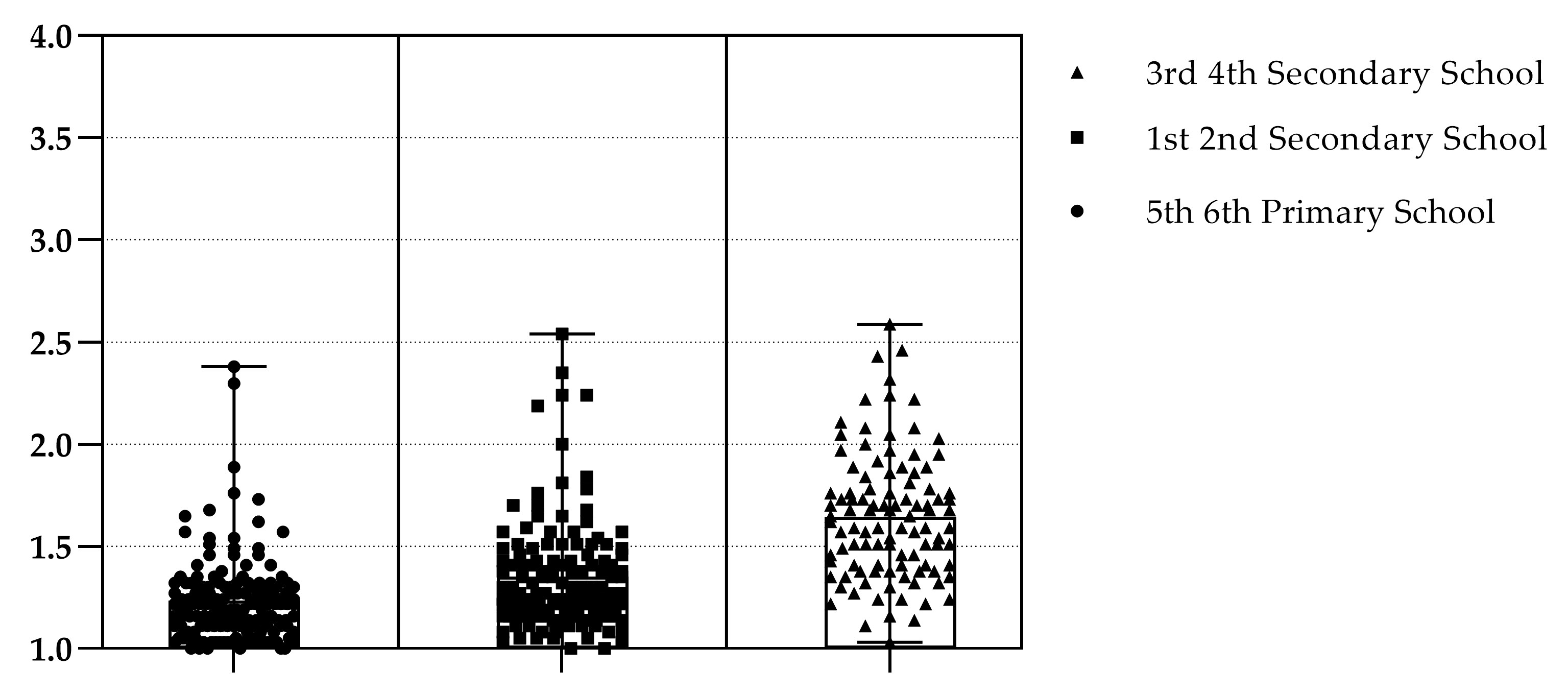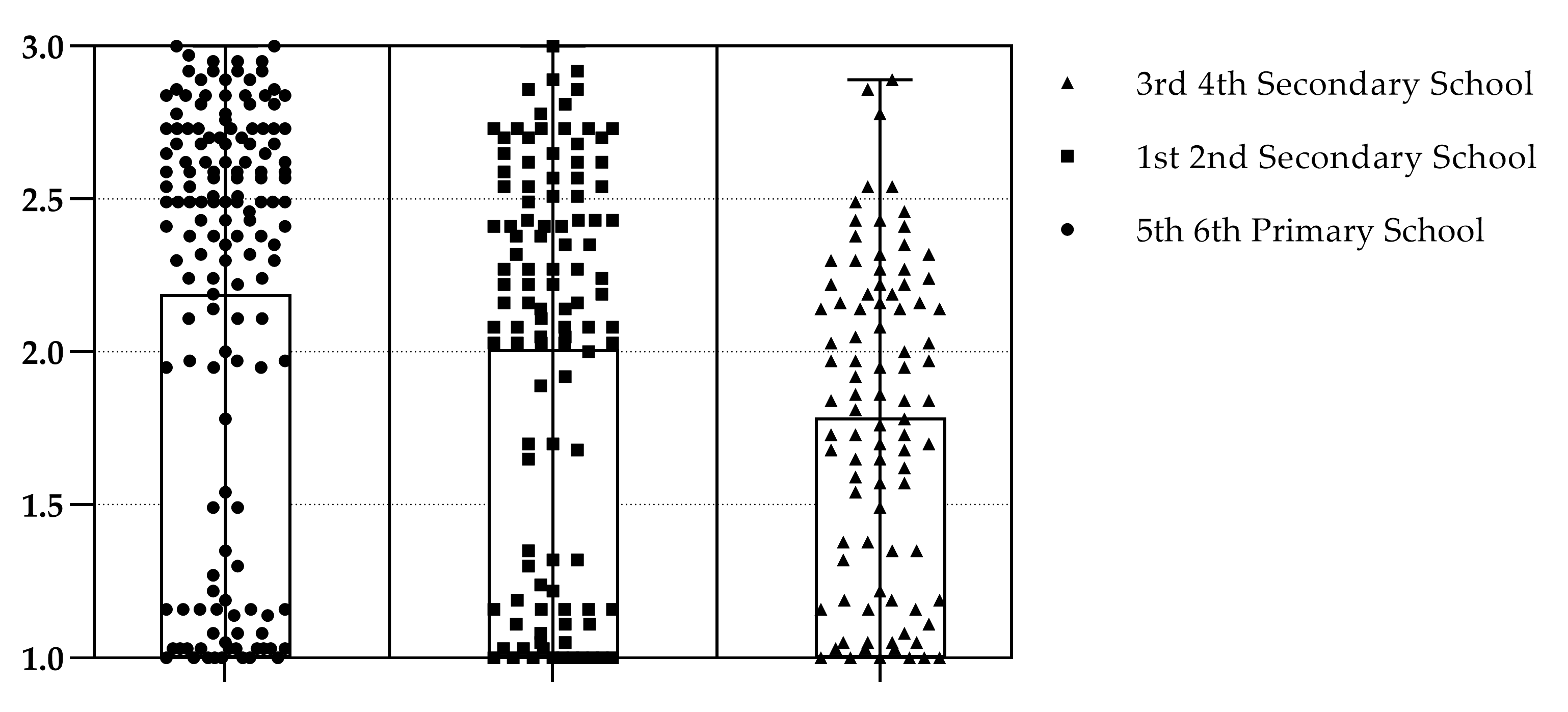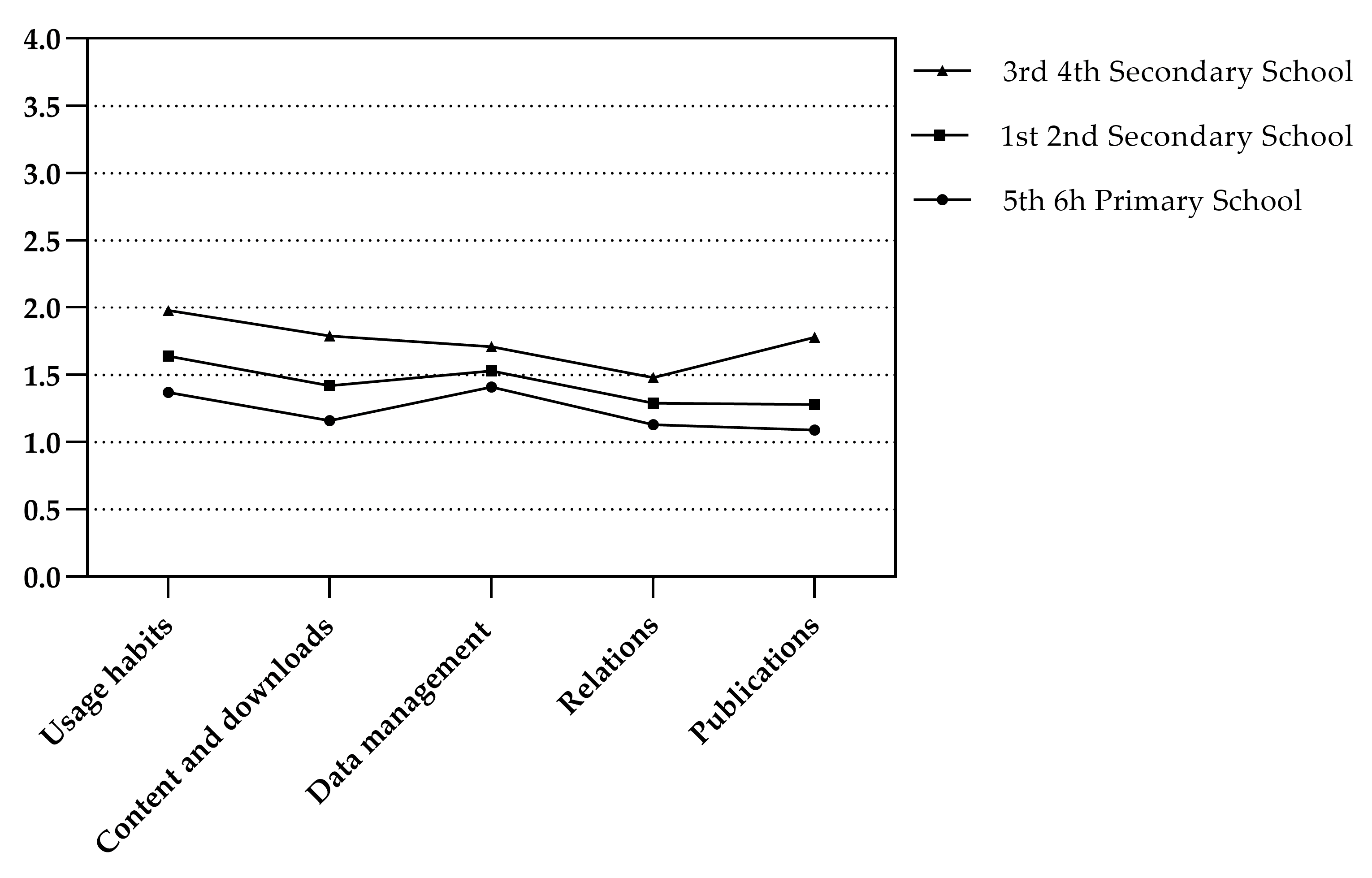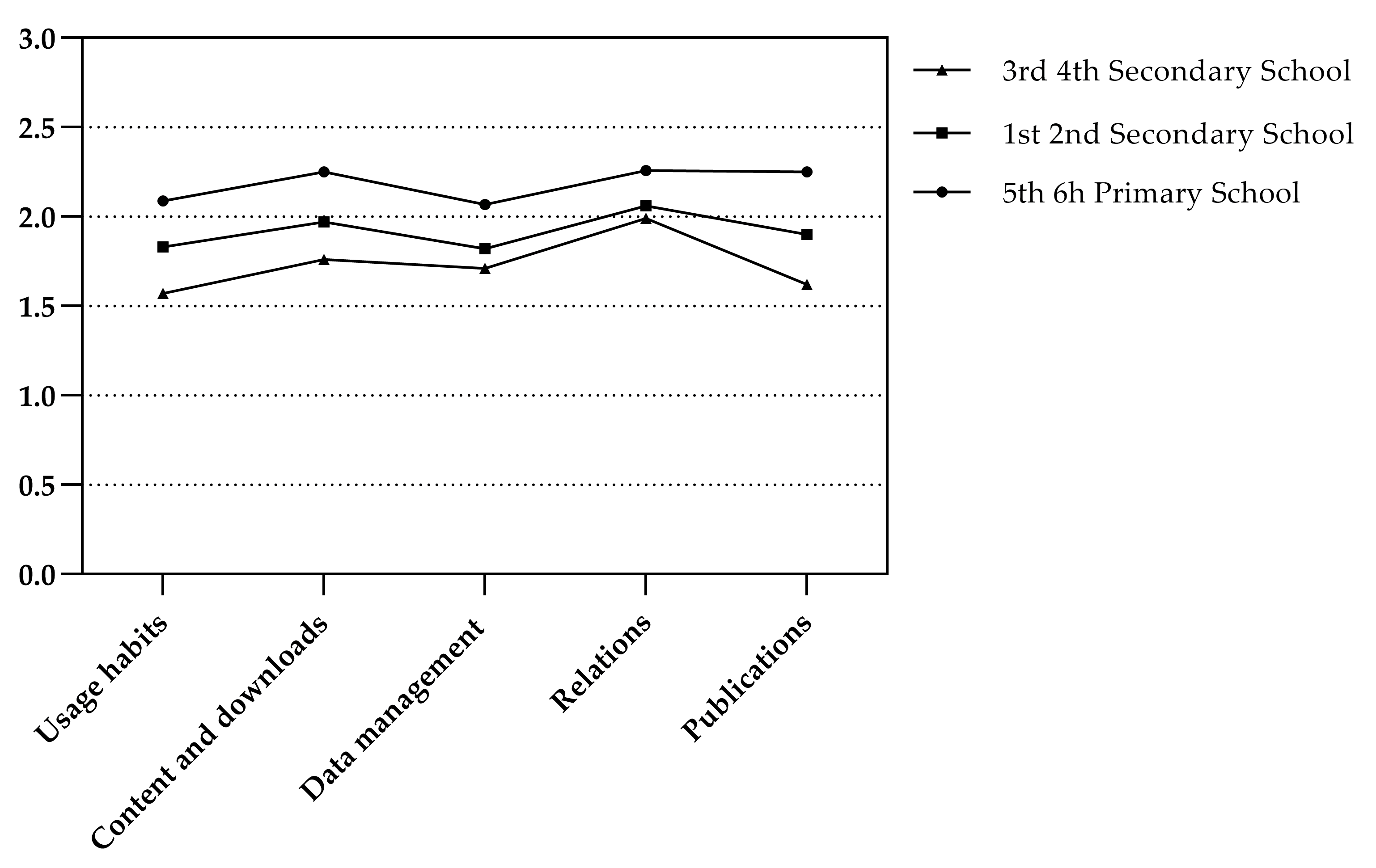Digital Technology and Teacher Professional Development: Challenges and Contradictions in Compulsory Education
Abstract
1. Introduction
1.1. Professional Development and Teacher Training
1.2. Professional Development and the Irruption of Digital Technology
1.3. Teacher Decision-Making Regarding the Use and Impact of Digital Technology: A Case Study of TPD
2. Materials and Methods
2.1. Design
2.2. Participation
2.3. Instrument
2.4. Procedure
2.5. Data Analysis
3. Results
3.1. Digital Technology and Adolescents: When Teachers Think Students Are Becoming More Competent Than They Are
3.2. Serious Games and Gamification: Buying and Selling Innovation
4. Discussion and Conclusions
Author Contributions
Funding
Institutional Review Board Statement
Informed Consent Statement
Data Availability Statement
Conflicts of Interest
References
- Escudero, J.M. El desarrollo profesional del profesorado: Ampliando miradas, decisiones y prácticas coherentes. Innov. Educ. 2022, 22, 1–13. [Google Scholar] [CrossRef]
- Loughran, J.; Hamilton, M.L. Developing an Understanding of Teacher Education. In International Handbook of Teacher Education: Volume 1; Loughran, J., Hamilton, M.L., Eds.; Springer: Singapore, 2016; pp. 3–22. ISBN 978-981-10-0366-0. [Google Scholar]
- Marcelo-Martínez, P.; Yot-Domínguez, C.; Marcelo, C. Los docentes y las redes sociales: Usos y motivaciones. Rev. Educ. Distancia RED 2023, 23, 1–20. [Google Scholar] [CrossRef]
- Darling-Hammond, L. Teacher Education around the World: What Can We Learn from International Practice? Eur. J. Teach. Educ. 2017, 40, 291–309. [Google Scholar] [CrossRef]
- Caride, J.A.; García Jiménez, E.; García López, E.; Gutiérrez Pérez, J. La formación inicial del profesorado de educación secundaria en Cataluña: Aportes para un debate que mira al futuro. Innov. Educ. 2022, 23, 1–20. [Google Scholar] [CrossRef]
- Hammerness, K.; Darling-Hammond, L.; Grossman, P.; Rust, F.; Shulman, L. How Teachers Learn & Develop. In The Design of Teacher Education Programs; Darling-Hammond, L., Bransford, J., Eds.; Jossey-Bass: San Francisco, CA, USA, 2005; pp. 358–389. ISBN 978-0-7879-7464-0. [Google Scholar]
- Susinos, T.; Romero Morante, J.; Ceballos López, N.; Saiz Linares, Á. Reforma de la formación inicial de docentes en clave ecosocial. La pandemia como maestra. Innov. Educ. 2022, 23, 1–19. [Google Scholar] [CrossRef]
- Marcelo, C. Empezar Con Buen Pie. Experiencias de Inducción y Acompañamiento a Docentes de Nuevo Ingreso; Octaedro: Barcelona, Spain, 2022; ISBN 978-84-19312-31-0. [Google Scholar]
- Marcelo, C. La iniciación a la enseñanza en España: 30 años de investigación como respuesta a una de las 24 propuestas de reforma. Innov. Educ. 2022, 23, 1–8. [Google Scholar] [CrossRef]
- Marcelo, C.; Vaillant, D. Desarrollo Profesional Docente: ¿Cómo se Aprende a Enseñar? Narcea Ediciones: Madrid, Spain, 2010; ISBN 978-84-277-1637-7. [Google Scholar]
- Montero, L. La Construcción Del Conocimiento Profesional Docente; Homo Sapiens Ediciones: Rosario, Argentina, 2001; ISBN 978-950-808-332-6. [Google Scholar]
- Unesco. Reimagining Our Futures Together: A New Social Contract for Education; Executive Summary. Available online: https://unesdoc.unesco.org/ark:/48223/pf0000379381 (accessed on 27 June 2023).
- Elliott, J. Reconstructing Teacher Education; Falmer Press: London, UK, 1993; ISBN 978-0-415-61517-4. [Google Scholar]
- Elliott, J. El “estudio de la enseñanza y del aprendizaje”: Una forma globalizadora de investigación del profesorado. Rev. Interuniv. Form. Profr. 2010, 68, 223–242. [Google Scholar]
- Schön, D. La Formación de Profesionales Reflexivos. Hacia Un Nuevo Diseño de La Enseñanza y El Aprendizaje En Las Profesiones; Paidós: Madrid, Spain, 1992; ISBN 978-84-7509-730-5. [Google Scholar]
- Pérez Gómez, A.; Barquín, J.; Angulo, J.F. Desarrollo Profesional Del Docente: Política, Investigación y Práctica; Akal: Madrid, Spain, 1999; ISBN 978-84-460-1128-6. [Google Scholar]
- Stenhouse, L. Investigación y Desarrollo Del Curriculum; Morata: Madrid, Spain, 1984; ISBN 978-84-7112-220-9. [Google Scholar]
- Tardiff, M. Los Saberes Del Docente y Su Desarrollo Profesional; Narcea: Madrid, Spain, 2004; ISBN 978-84-277-1450-2. [Google Scholar]
- Tardiff, M. El Oficio Docente En La Actualidad. Perspectivas Internacionales y Desafíos a Futuro. In Políticas Docentes: Formación, Trabajo y Desarrollo Profesional; Instituto Internacional de Planeamiento de la Educación IIPE-Unesco: Buenos Aires, Argentina, 2013; ISBN 978-987-1875-25-2. [Google Scholar]
- Zeichner, K.; Nofke, S. Practitioner Research. In Handbook of Research on Teaching; American Educational Research Association: Washington, DC, USA, 2001; pp. 298–330. [Google Scholar]
- Manfra, M.M. Action Research and Systematic, Intentional Change in Teaching Practice. Rev. Res. Educ. 2019, 43, 163–196. [Google Scholar] [CrossRef]
- Imbernón, F. Desarrollo personal, profesional e institucional y formación del profesorado. Algunas tendencias para el siglo XXI. QURRICULUM—Rev. Teoría Investig. Práct. Educ. 2020, 33, 49–67. [Google Scholar] [CrossRef]
- Ministerio de Educación y Formación Profesional. Documento Para Debate. 24 Propuestas de Reforma Para La Mejora de La Profesión Docente 2022. Available online: https://www.educacionyfp.gob.es/dam/jcr:11de0388-9df4-4846-af56-fe19fc82dbaf/documento-de-debate-24-propuestas-de-reforma-profesi-n-docente.pdf (accessed on 1 March 2023).
- Faure, E.; Herrera, F.; Abdul-Razzak, K.; Lopes, H.; Petrovski, A.; Rahnema, M.; Champion Ward, F. Aprender a Ser. La Educación Del Futuro; Alianza/Unesco: Madrid, Spain, 1973; ISBN 92-3-301017-1. [Google Scholar]
- Goble, N.; Porter, J. La Cambiante Función Del Profesor. Perspectivas Internacionales; Narcea: Madrid, Spain, 1980; ISBN 978-84-277-0399-5. [Google Scholar]
- Blackburn, V.; Moisan, C. La Formation Continue Des Enseignants Dans Les Douze Etats Membres de La Communante Europeenne; Presses Interuniversitaires Europeennes: Maastricht, The Netherlands, 1986; ISBN 978-90-70776-15-2. [Google Scholar]
- Delors, J. La Educación Encierra Un Tesoro; UNESCO/Santillana: Madrid, Spain, 1996; ISBN 978-968-7474-00-7. [Google Scholar]
- Ferry, G. Le Traject de La Formation. Les Enseignants Entre La Théorie El La Pratique; Durnord: Paris, France, 2003; ISBN 978-2-296-32135-9. [Google Scholar]
- Goad, L.H. Preparing Teacher for Life-Long Education. The Report of a Multinational Study of Some Developments in Teacher Education in the Perspective of Lifelong Education; Unesco Institute for Education y Pergamon Press: Hamburgo, Germany; Oxford, UK, 1984; ISBN 978-1-4832-9931-0. [Google Scholar]
- Lanier, J.; Little, J.W. Research on Teacher Education. In Handbook of Research on Teaching, 3rd ed.; MacMillan Publishing Company: New York, NY, USA, 1986; pp. 527–569. [Google Scholar]
- Fullan, M.; Hargreaves, A. Teacher Development and Educational Change; The Falmer Press: London, UK, 1992; ISBN 978-1-317-97348-5. [Google Scholar]
- Imbernón, F. La Formación y El Desarrollo Profesional Del Profesorado; Graó: Barcelona, Spain, 1994; ISBN 978-84-7827-106-1. [Google Scholar]
- Marcelo, C. Formación Del Profesorado Para El Cambio Educativo; PPU: Barcelona, Spain, 1994; ISBN 978-84-89607-06-4. [Google Scholar]
- Marcelo, C. Constantes y desafíos actuales de la profesión docente. Rev. Educ. 1995, 306, 205–242. [Google Scholar]
- Pérez Gómez, Á. La Cultura Escolar En La Sociedad Neoliberal; Morata: Madrid, Spain, 1998; ISBN 978-84-7112-431-9. [Google Scholar]
- Sparks, D.; Loucks-Horsley, S. Models of Staff Development. In Handbook of Research on Teacher Education; McMillan: New York, NY, USA, 1990; pp. 234–250. [Google Scholar]
- Sprinthall, N.; Reiman, A.J.; This-Sprinthall, L. Teacher Professional Development. In Handbook of Research on Teacher Education; Sikula, J., Ed.; McMillan: New York, NY, USA, 1996; pp. 666–703. [Google Scholar]
- Alonso-Ferreiro, A.; Gewerc, A. ICT teachers’ lifelong training in Galicia: Do we always trip over the same stone? Innov. Educ. 2015, 25, 269–282. [Google Scholar] [CrossRef]
- Fraga Varela, F.; Vila Couñago, E.; Martínez Piñeiro, E. Información y Alfabetización Digital de los preadolescentes gallegos (España): Un estudio mixto. Inf. Data Lit. Galician (Spain) Tweens Mix. Study 2020, 38, 17–32. [Google Scholar] [CrossRef]
- Fraga-Varela, F.; Rodríguez-Groba, A. Dilemas y desafíos de la tecnología educativa en el EEES: Percepciones y creencias de futuros maestros. Profr. Rev. Curric. Form. Profr. 2017, 21, 123–142. [Google Scholar] [CrossRef]
- Gewerc, A. Identidad Profesional y Trayectoria En La Universidad. Profr. Rev. Curric. Form. Profr. 2001, 2, 31–46. [Google Scholar]
- Gewerc, A.; Martínez-Piñeiro, E. Competencia Digital y Preadolescencia. Los Desafíos de La e-Inclusión; Editorial Síntesis: Madrid, Spain, 2019; ISBN 978-84-9171-381-4. [Google Scholar]
- Montero, L. O Valor Do Envoltorio. Un Estudo Da Influencia Das TIC Nos Centros Educativos; Xerais: Vigo, Spain, 2007; ISBN 978-84-9782-647-1. [Google Scholar]
- Montero, L.; Gewerc, A. Una Historia, Cuatro Historias. Acompañar Proyectos de Innovación Educativa Con Las TIC; Graó: Barcelona, Spain, 2013; ISBN 978-84-9980-599-3. [Google Scholar]
- Hargreaves, A.; Fullan, M. Capital Profesional. Transformar La Enseñanza En Cada Escuela; Morata: Madrid, Spain, 2014; ISBN 978-84-7112-725-9. [Google Scholar]
- Novoa, A.; Alvim, Y. Escolas e Professores. Proteger, Transformar, Valorizar; SEC/IAT: Salvador, Brazil, 2022; ISBN 978-65-993687-1-4. [Google Scholar]
- Pérez Gómez, Á. Ser docente en tiempos de incertidumbre y perplejidad. Márgenes Rev. Educ. Univ. Málaga 2019, 3–18. [Google Scholar] [CrossRef]
- Trillo, F.; Nieto, J.M.; Martínez, B.; Escudero, J.M. El desarrollo profesional y la colaboración docente: Un análisis situado en el contexto español de las tensiones y fracturas entre la teoría y la práctica. Educ. Policy Anal. Arch. 2017, 25, 117. [Google Scholar] [CrossRef]
- Bruner, J. Acts of Meaning: Four Lectures on Mind and Culture; Harvard University Press: Cambridge, MA, USA, 1993; ISBN 978-0-674-00361-3. [Google Scholar]
- Abi-Jaoude, E.; Naylor, K.T.; Pignatiello, A. Smartphones, Social Media Use and Youth Mental Health. CMAJ 2020, 192, E136–E141. [Google Scholar] [CrossRef]
- Fabris, M.A.; Marengo, D.; Longobardi, C.; Settanni, M. Investigating the Links between Fear of Missing out, Social Media Addiction, and Emotional Symptoms in Adolescence: The Role of Stress Associated with Neglect and Negative Reactions on Social Media. Addict. Behav. 2020, 106, 106364. [Google Scholar] [CrossRef]
- Keles, B.; McCrae, N.; Grealish, A. A Systematic Review: The Influence of Social Media on Depression, Anxiety and Psychological Distress in Adolescents. Int. J. Adolesc. Youth 2020, 25, 79–93. [Google Scholar] [CrossRef]
- Royal Society for Public Health Social Media and Young People’s Mental Health and Wellbeing 2017. Available online: https://www.rsph.org.uk/static/uploaded/d125b27c-0b62-41c5-a2c0155a8887cd01.pdf (accessed on 10 March 2023).
- European Commission. Recommendation of the European Parliament and of the Council of 18 December 2006 on Key Competences for Lifelong Learning. Available online: http://data.europa.eu/eli/reco/2006/962/oj/eng (accessed on 13 March 2023).
- Ministerio de Educación y Formación Profesional. Ley Orgánica 3/2020, de 29 de Diciembre, Por La Que Se Modifica La Ley Orgánica 2/2006, de 3 de Mayo, de Educación. Available online: https://www.boe.es/eli/es/lo/2020/12/29/3/con (accessed on 12 March 2023).
- Vuorikari, R.; Kluzer, S.; Punie, Y. DigComp 2.2: The Digital Competence Framework for Citizens—With New Examples of Knowledge, Skills and Attitudes. Available online: https://publications.jrc.ec.europa.eu/repository/handle/JRC128415 (accessed on 4 November 2022).
- Fraga-Varela, F.; Vila-Couñago, E.; Martínez-Piñeiro, E. Impacto de los juegos serios en la fluidez matemática: Un estudio en Educación Primaria. Comun. Rev. Cient. Comun. Educ. 2021, 29, 125–135. [Google Scholar] [CrossRef]
- Michael, D.R.; Chen, S. Serious Games: Games That Educate, Train and Inform; Thomson Course Technology: Boston, MA, USA, 2006; ISBN 978-1-59200-622-9. [Google Scholar]
- Clark, D.B.; Tanner-Smith, E.E.; Killingsworth, S.S. Digital Games, Design, and Learning: A Systematic Review and Meta-Analysis. Rev. Educ. Res. 2016, 86, 79–122. [Google Scholar] [CrossRef] [PubMed]
- Wouters, P.; van Nimwegen, C.; van Oostendorp, H.; van der Spek, E.D. A Meta-Analysis of the Cognitive and Motivational Effects of Serious Games. J. Educ. Psychol. 2013, 105, 249–265. [Google Scholar] [CrossRef]
- de Carvalho, C.V.; Rodríguez, M.C.; Nistal, M.L.; Hromin, M.; Bianchi, A.; Heidmann, O.; Tsalapatas, H.; Metin, A. Using Video Games to Promote Engineering Careers. Int. J. Eng. Educ. 2018, 34, 388–399. [Google Scholar]
- van der Ven, F.; Segers, E.; Takashima, A.; Verhoeven, L. Effects of a Tablet Game Intervention on Simple Addition and Subtraction Fluency in First Graders. Comput. Hum. Behav. 2017, 72, 200–207. [Google Scholar] [CrossRef]
- Cozad, L. Effects of a Digital Mathematics Fluency Program on the Fluency and Generalization of Learners; The Pennsylvania State University: State College, PA, USA, 2019. [Google Scholar]
- Cress, T. Influence of the Reflex Math Fact Fluency Program on Math Scores. Ph.D. Thesis, Walden University, Minneapolis, MN, USA, 2019. [Google Scholar]
- Mateo, J. La Investigación Ex Post-Facto. In Metodología de la Investigación Educativa; Bisquerra, R., Ed.; La Muralla: Madrid, Spain, 2004; pp. 195–230. [Google Scholar]
- Martínez de Morentin, J.I.; Lareki, A.; Altuna, J.; Amenabar, N. Cuestionario: Anomia Digital. In Uso de Las Tecnologías Digitales y Comportamientos Inadecuados; Universidad del País Vasco (UPV/EHU): Biscay, Spain, 2018. [Google Scholar]
- Lareki, A.; Martínez de Morentin, J.I.; Altuna, J.; Amenabar, N. Teenagers’ Perception of Risk Behaviors Regarding Digital Technologies. Comput. Hum. Behav. 2017, 68, 395–402. [Google Scholar] [CrossRef]
- Lareki, A.; Altuna, J.; Martínez de Morentin, J.I.; Amenabar, N. Young People and Digital Services: Analysis of the Use, Rules, and Age Requirement. Child. Youth Serv. Rev. 2017, 79, 126–131. [Google Scholar] [CrossRef]
- González-Santana, A.; Martínez de Morentin, J.I.; Altuna, J. Análisis Del Cuestionario Sobre La Anomia Digital: Percepción de Riesgos de Las Madres y Los Padres de Adolescentes En El Uso de Tecnologías Digitales. In Proceedings of the La Competencia y Ciudadanía Digital para la Transformación Social: XXVI Jornadas Universitarias de Tecnología Educativa, San Sebastián, Spain, 27–29 June 2018; Losada, D., Fernández-Olaskoaga, L., Correa, J.M., Eds.; Universidad del País Vasco: San Sebastián, Spain, 2018; pp. 219–224. [Google Scholar]
- Foegen, A.; Deno, S.L. Identifying Growth Indicators for Low-Achieving Students in Middle School Mathematics. J. Spec. Educ. 2001, 35, 4–16. [Google Scholar] [CrossRef]
- Sarrell, D.M. The Effects of Reflex Math as a Response to Intervention Strategy to Improve Math Automaticity among Male and Female At-Risk Middle School Students; Liberty University: Lynchburg, VA, USA, 2014. [Google Scholar]
- Tomczak, M.; Tomczak, E. The Need to Report Effect Size Estimates Revisited. An Overview of Some Recommended Measures of Effect Size. Trends Sport Sci. 2014, 21, 19–25. [Google Scholar]
- Fritz, C.O.; Morris, P.E.; Richler, J.J. Effect Size Estimates: Current Use, Calculations, and Interpretation. J. Exp. Psychol. Gen. 2012, 141, 2–18. [Google Scholar] [CrossRef]
- Cohen, J. Statistical Power Analysis for the Behavioral Sciences; L. Erlbaum Associates: Hillsdale, NJ, USA, 1988; ISBN 978-0-8058-0283-2. [Google Scholar]
- European Commission. Council Recommendation of 22 May 2018 on Key Competences for Lifelong Learning (Text with EEA Relevance). Available online: https://eur-lex.europa.eu/legal-content/EN/TXT/?uri=CELEX%3A32018H0604%2801%29&qid=1643797485584 (accessed on 21 March 2023).
- Redecker, C.; Punie, Y. European Framework for the Digital Competence of Educators: DigCompEdu. Available online: https://publications.jrc.ec.europa.eu/repository/handle/JRC107466 (accessed on 7 January 2023).
- Berrios Aguayo, B.; Pérez García, B.; Sánchez Valenzuela, F.; Pantoja Vallejo, A. Análisis del programa educativo “Cubilete” para la prevención de adicciones a TIC en adolescentes: Caso específico de juegos de azar y apuestas online. Rev. Esp. Orientación Psicopedag. 2020, 31, 26–42. [Google Scholar] [CrossRef]
- Vanderhoven, E.; Schellens, T.; Valcke, M. Enseñar a los adolescentes los riesgos de las redes sociales: Una propuesta de intervención en Secundaria. Comun. Rev. Cient. Iberoam. Comun. Educ. 2014, 22, 123–132. [Google Scholar] [CrossRef]
- Montero, L. Relaciones entre teoría y práctica en la formación inicial. Percepciones de formadores y estudiantes del Grado de Maestro en Educación primaria. Educ. Siglo XXI 2018, 36, 303–330. [Google Scholar] [CrossRef]
- Fraga-Varela, F.; Alonso-Ferreiro, A. Digital Competence in Primary Education and the Limits of 1:1 Computing. Can. J. Learn. Technol. 2022, 48, 1–18. [Google Scholar] [CrossRef]
- Montero, L.; Gewerc, A. De la innovación deseada a a innovación posible. Escuelas alteradas por las TIC. Profr. Rev. Curríc. Form. Profr. 2010, 14, 303–318. [Google Scholar]





| Pre-Test Scores | Post-Test Scores | Days of Use | Number of Activities | |||||||||
|---|---|---|---|---|---|---|---|---|---|---|---|---|
| M | Md | SD | M | Md | SD | M | Md | SD | M | Md | SD | |
| 1st (n = 69) | 2.97 | 2 | 3.16 | 12.80 | 13 | 5.43 | 28.3 | 27 | 4.9 | 5662.4 | 4775 | 2829.6 |
| 2nd (n = 72) | 8.64 | 8 | 3.651 | 20.99 | 20.5 | 8.139 | 29.6 | 28.5 | 6.1 | 6775.5 | 5733.5 | 3918.5 |
| 3rd (n = 73) | 10.64 | 10 | 4.66 | 15.45 | 15 | 5.71 | 29.4 | 29 | 8.7 | 6620.1 | 6344 | 3315.3 |
| 4th (n = 70) | 13.57 | 13 | 6.04 | 21.84 | 21 | 6.52 | 21.3 | 20.5 | 5.2 | 3865.4 | 3445 | 1890.6 |
Disclaimer/Publisher’s Note: The statements, opinions and data contained in all publications are solely those of the individual author(s) and contributor(s) and not of MDPI and/or the editor(s). MDPI and/or the editor(s) disclaim responsibility for any injury to people or property resulting from any ideas, methods, instructions or products referred to in the content. |
© 2023 by the authors. Licensee MDPI, Basel, Switzerland. This article is an open access article distributed under the terms and conditions of the Creative Commons Attribution (CC BY) license (https://creativecommons.org/licenses/by/4.0/).
Share and Cite
Montero-Mesa, L.; Fraga-Varela, F.; Vila-Couñago, E.; Rodríguez-Groba, A. Digital Technology and Teacher Professional Development: Challenges and Contradictions in Compulsory Education. Educ. Sci. 2023, 13, 1029. https://doi.org/10.3390/educsci13101029
Montero-Mesa L, Fraga-Varela F, Vila-Couñago E, Rodríguez-Groba A. Digital Technology and Teacher Professional Development: Challenges and Contradictions in Compulsory Education. Education Sciences. 2023; 13(10):1029. https://doi.org/10.3390/educsci13101029
Chicago/Turabian StyleMontero-Mesa, Lourdes, Fernando Fraga-Varela, Esther Vila-Couñago, and Ana Rodríguez-Groba. 2023. "Digital Technology and Teacher Professional Development: Challenges and Contradictions in Compulsory Education" Education Sciences 13, no. 10: 1029. https://doi.org/10.3390/educsci13101029
APA StyleMontero-Mesa, L., Fraga-Varela, F., Vila-Couñago, E., & Rodríguez-Groba, A. (2023). Digital Technology and Teacher Professional Development: Challenges and Contradictions in Compulsory Education. Education Sciences, 13(10), 1029. https://doi.org/10.3390/educsci13101029







